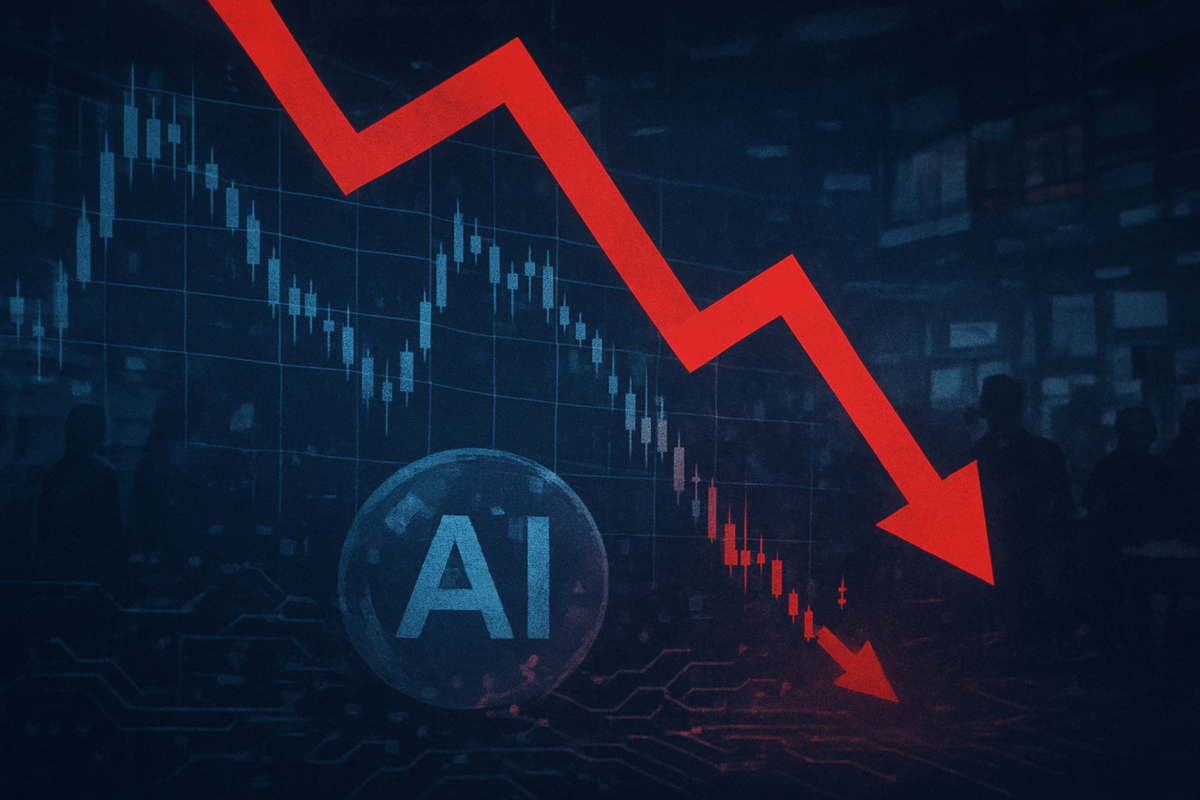
November 4, 2025, witnessed a notable downturn in U.S. stock futures, with the Dow Jones Industrial Average, S&P 500, and Nasdaq 100 all pointing sharply lower. This retreat signals a potential shift in market sentiment, moving away from the robust gains seen in October. While the immediate trigger appears to be profit-taking after a significant rally, underlying concerns about elevated valuations, particularly in the burgeoning artificial intelligence sector, are beginning to surface. The technology sector, a key driver of recent market strength, showed particular vulnerability, raising questions about the sustainability of current growth trajectories.
Market Futures Sink, Tech Giants Under Pressure as Profit-Taking Takes Hold
November 4, 2025, marked a notable retreat across major U.S. stock futures, signaling a pause in the bullish momentum that characterized October. Early trading saw Dow Jones Industrial Average (NYSE: DJIA) futures decline by 0.63% to 0.8%, while S&P 500 (NYSE: SPX) futures fell between 0.9% and 1.1%. The technology-heavy Nasdaq 100 (NASDAQ: NDX) futures experienced the steepest drop, ranging from 1.2% to 1.4%, reflecting significant pressure on the tech sector. This pre-market slump in U.S. futures mirrored losses in Asian markets and preceded a lower open for European bourses, indicating a widespread cautious sentiment.
The technology sector, a primary engine of recent market gains, bore the brunt of the downturn. Despite reporting robust third-quarter 2025 results that surpassed analyst expectations and raising its full-year revenue outlook, Palantir Technologies (NYSE: PLTR) saw its shares plunge by over 4% in pre-market trading, with some reports indicating a 7% drop. This paradoxical decline, despite strong fundamentals, was attributed to concerns over the company's elevated valuation, which analysts suggested had already priced in substantial future growth. Palantir's stock had surged over 150% year-to-date and closed at a record $207.18 on Monday, November 3, boasting a price-to-sales ratio of 85, the highest within the S&P 500 Index.
Other prominent tech players also faced headwinds. Advanced Micro Devices (NASDAQ: AMD) shares were down 2.5% in pre-market trading, ahead of its quarterly results release after market close. Investor sentiment for AMD had been largely positive leading up to this date, fueled by a multi-billion-dollar partnership with OpenAI and Oracle Cloud's (NYSE: ORCL) selection of AMD's GPUs for its next-generation AI supercomputers. Oracle (NYSE: ORCL) itself saw its stock decline by 2% in pre-market, having already returned -11.6% in the month prior to November 4, following slightly missed earnings estimates in its September 9, 2025, quarterly report.
This market correction unfolded against a backdrop of an ongoing U.S. government shutdown, which limited the release of key economic data, further contributing to uncertainty. The previous day, November 3, 2025, had seen mixed closings, with the Nasdaq Composite (NASDAQ: COMP) and S&P 500 (NYSE: SPX) gaining on AI optimism, while the Dow Jones Industrial Average (NYSE: DJIA) slipped amid "AI bubble" worries. The robust market performance in October, driven by AI enthusiasm, strong corporate earnings, and a Federal Reserve rate cut, now appears to be giving way to profit-taking and a reevaluation of asset valuations, with executives like Morgan Stanley (NYSE: MS) CEO Ted Pick warning of potential pullbacks. The "fear gauge," the VIX index of stock volatility, jumped, signaling increased investor apprehension globally.
Shifting Tides: Who Wins and Loses in a Cautious Market
The market's cautious turn on November 4, 2025, particularly the struggles within the technology sector, is poised to create a distinct divide between potential winners and losers. Companies with high valuations, especially those in the high-growth, often unprofitable tech space, are likely to face significant headwinds. The recent surge in stock prices, particularly among the "Magnificent 7" mega-cap tech firms, has led to elevated price-to-earnings (P/E) ratios—the S&P 500 (NYSE: SPX) trading at a 42% premium and the technology sector at a 66% premium to their 20-year averages. This makes them highly susceptible to profit-taking and a reevaluation of future growth prospects, especially if an economic slowdown or rising interest rates make future earnings less valuable.
Among the likely "losers" are high-growth, often unprofitable tech companies, particularly those in Software-as-a-Service (SaaS) and other speculative ventures, whose valuations are built on future potential rather than current cash flow. Consumer discretionary tech and "sharing economy" companies, such as e-commerce platforms (beyond essential goods) and ride-sharing services, could also see reduced demand as consumers tighten their belts during economic uncertainty. Furthermore, companies with substantial debt loads may struggle with increased borrowing costs, while businesses heavily reliant on advertising revenue, like many social media platforms, could see ad budgets curtailed. Diversified semiconductor makers, sensitive to broad economic swings, and companies with poor cash flow are also at heightened risk.
Conversely, defensive sectors and value stocks are expected to demonstrate resilience, potentially emerging as "winners." Industries providing essential goods and services, whose demand remains inelastic regardless of economic conditions, are well-positioned. This includes healthcare, consumer staples (food, beverages, household products), and public utilities (electricity, water, gas), which offer stability due to consistent demand and often regulatory protection. Discount retailers may also see increased traffic as consumers become more cost-conscious.
Beyond traditional defensive plays, certain technology segments and investment strategies could also thrive. Cybersecurity, a non-negotiable expenditure for businesses in an increasingly digital and threat-laden landscape, is likely to see continued investment. Core technology and cloud infrastructure providers, such as Amazon Web Services (NASDAQ: AMZN) and Microsoft Azure (NASDAQ: MSFT), may also prove resilient as businesses prioritize maintaining virtual workforces and operational efficiency. Companies with strong balance sheets and ample cash reserves possess "dry powder" to weather economic storms, acquire distressed assets, or continue strategic investments. For savvy investors, market downturns present opportunities for short selling, purchasing put options, or engaging in dollar-cost averaging to acquire quality stocks at lower prices, positioning their portfolios for the eventual market rebound.
Broader Implications: Navigating the Crossroads of Innovation and Valuation
The market's retreat on November 4, 2025, particularly the pronounced weakness in technology stocks, carries wider significance beyond immediate price movements. This event underscores the ongoing tension between rapid technological advancement and sustainable market valuations, fitting into broader industry trends marked by macroeconomic headwinds and intense scrutiny of the artificial intelligence (AI) boom. The tech sector, while an undeniable engine of innovation, remains highly sensitive to factors like rising interest rates and persistent inflation, which increase borrowing costs and reduce the present value of future cash flows, disproportionately impacting high-growth, often unprofitable tech firms.
The current market environment is heavily influenced by the fervent optimism surrounding AI, with American private AI investment reaching unprecedented levels in 2025. This has fueled remarkable stock surges for companies contributing to AI, from chip manufacturers to software developers. However, this enthusiasm is increasingly accompanied by concerns of an "AI bubble," drawing parallels to the dot-com bust of 2000. Warnings from financial institutions and even industry leaders about "overexcited" investors and "insane" AI valuations highlight the risk. A significant portion of generative AI business efforts are reportedly failing to achieve substantial revenue growth, suggesting that the market's current valuations may not always be justified by tangible returns. This downturn could serve as a critical "reality check," separating genuinely transformative AI companies from those whose valuations are purely speculative.
The ripple effects of a tech-led downturn are extensive. Smaller, growth-oriented tech companies, reliant on external funding and often operating at a loss, would be particularly vulnerable to increased borrowing costs and reduced venture capital. This could slow their expansion and even threaten their viability. The interconnected nature of the tech supply chain, especially in semiconductors, means struggles among major players could cascade, impacting partners and industries globally. Given that "Big Tech" constitutes a significant portion of overall market indices (e.g., about 35% of the S&P 500 (NYSE: SPX)), a sell-off in these heavyweight stocks could trigger broader market contagion, shifting investments from riskier tech assets to more stable sectors like utilities, consumer staples, and healthcare, and potentially signaling or exacerbating a wider economic slowdown.
From a regulatory and policy perspective, a tech stock downturn could intensify existing governmental scrutiny on the technology sector. Governments worldwide are already increasing oversight on Big Tech, focusing on antitrust, data privacy, and the ethical implications of AI. Market instability might accelerate these efforts, driven by concerns over market concentration and systemic risk. This could lead to more stringent antitrust investigations, new data privacy regulations, and stronger rules governing the ethical use and safety of AI systems, increasing compliance costs and potentially disrupting existing business models. Geopolitical tensions, such as US chip export restrictions to China, also remain a significant factor, with a downturn potentially leading to further protectionist policies and reshaping global supply chains. Historically, the current situation draws comparisons to the dot-com bubble burst of 2000, where speculative valuations led to a dramatic market correction, and the 2022 tech correction, which demonstrated the rapid shift in investor sentiment when borrowing costs rise. While today's dominant tech companies often possess stronger fundamentals than their dot-com predecessors, the high concentration of market value in a few AI-heavy giants presents its own set of systemic risks.
The Road Ahead: Navigating Volatility and Opportunities in a Shifting Market
The market downturn on November 4, 2025, particularly the struggles observed in technology stocks, marks a pivotal moment that will shape both short-term market dynamics and long-term strategic adaptations. In the immediate aftermath, continued volatility is highly probable as investors reassess valuations, especially within the AI sector, which has seen substantial gains and raised "bubble" concerns. This period of caution may trigger a rotation from growth stocks, often tech-heavy, towards value stocks, as profit growth is anticipated not only in mega-cap tech but also in cyclical and value-style investments. The uncertainty surrounding future interest rate cuts by the Federal Reserve, influenced by persistent inflation concerns, will remain a critical factor, potentially keeping equity investors cautious. However, should the Fed eventually signal an easing of monetary policy, it could provide a much-needed boost to the market.
Looking further ahead, the long-term outlook for technology and the broader market remains generally positive, underpinned by resilient economic fundamentals and relentless innovation. The current bull market is expected to continue, albeit with potentially more moderate gains and increased volatility. Artificial intelligence, despite short-term valuation concerns, is unequivocally a transformative technology with immense long-term potential across industries. Companies deeply integrated with AI, focusing on hardware, software, and services, are poised for continued strong performance. This emphasizes the importance of diversification beyond mega-cap tech, broadening market leadership and offering opportunities in other sectors.
For companies, particularly in the tech sector, strategic pivots will be essential. A shift in focus from hyper-growth at all costs to demonstrating clear paths to profitability and operational efficiency will be paramount. This includes optimizing capital spending, streamlining manufacturing processes, and adapting value propositions to align with evolving customer needs. Despite overall caution, selective and increased investment in emerging technologies like AI, cybersecurity, cloud computing, and data analytics will be crucial for maintaining competitiveness and driving future growth. Agile strategy development, focusing on immediate opportunities while also laying out clear long-term aspirations, will be key to navigating fast-moving markets.
The current environment presents both significant market opportunities and challenges. The continued advancement and integration of AI across various industries offer substantial growth avenues for companies that can effectively leverage it for diagnostics, financial optimization, and autonomous systems. The ever-increasing demand for cybersecurity solutions and the robust growth of cloud computing also represent stable and impactful fields for investment. However, challenges persist, including elevated valuations in certain tech and AI stocks, which pose a risk of price corrections if high earnings expectations are not met. A prolonged elevated interest rate environment could keep equity investors cautious, impacting smaller enterprises and M&A activity. Geopolitical risks and trade policy uncertainties further weigh on market sentiment and global economic growth, while the risk of overinvestment in AI infrastructure could lead to excess competition and potentially poor returns. Potential scenarios range from a resilient recovery, where strong corporate earnings and a resilient consumer base mitigate headwinds, to extended volatility if inflation persists, or even a bear market if coupled with a significant economic downturn. The interplay of AI's transformative power, the Federal Reserve's interest rate decisions, and fluctuating investor sentiment will ultimately dictate the market's trajectory.
A Market in Flux: Navigating Uncertainty and Opportunity
November 4, 2025, served as a stark reminder of the inherent volatility in financial markets, particularly within the high-flying technology sector. The day's downturn, characterized by a significant dip in U.S. stock futures and pronounced struggles among several tech giants, underscored a critical re-evaluation by investors. While the transformative power of artificial intelligence (AI) continues to fuel growth in some mega-cap tech stocks, investor scrutiny has intensified on company valuations and future visibility, leading to sharp declines for specific firms like Palantir Technologies (NYSE: PLTR) despite strong earnings. Broader market sentiment was further affected by geopolitical tensions, a prolonged U.S. government shutdown, and widespread profit-taking after recent rallies. This day highlighted a clear divergence: robust performance for AI-leading companies versus challenges for others facing specific headwinds or perceived overvaluations.
Moving forward, the market is poised for continued volatility, influenced by geopolitical developments and evolving monetary policies. The AI sector will undoubtedly maintain its role as a key growth driver, but investors will increasingly differentiate between robust, sustainable growth models and speculative valuations. The ongoing U.S. government shutdown represents a significant domestic risk that could impact economic sentiment and activity. Globally, the economy continues to grapple with headwinds, including policy fragmentation and structural shifts, even as some regions demonstrate resilience. Leading financial institutions like Goldman Sachs (NYSE: GS) and Morgan Stanley (NYSE: MS) have suggested that such corrections are normal and even healthy, indicating a shift towards a more discerning investment landscape where fundamental analysis becomes paramount.
The lasting significance of these events lies in their potential to redefine investment priorities. While technological innovation, particularly in AI, can powerfully drive market segments, the emphasis is now firmly on traditional valuation metrics and clear long-term outlooks to instill investor confidence. The political climate, exemplified by the U.S. government shutdown, further highlights the growing impact of non-economic factors on market stability. This period encourages a more cautious and selective approach to investing, rewarding companies with strong fundamentals, clear paths to profitability, and resilient business models.
For investors navigating the coming months, several key indicators warrant close attention:
- Inflation Trends and Central Bank Policy: Monitor consumer price index (CPI) data and communications from central banks, especially the Federal Reserve. Any unexpected shifts in inflation or interest rate policy could trigger significant market responses.
- AI Sector Performance and Due Diligence: While AI remains a compelling theme, investors should conduct thorough due diligence, focusing on companies with clear revenue streams, sustainable growth models, and realistic valuations rather than solely on speculative hype.
- Resolution of Political Uncertainties: The duration and resolution of the U.S. government shutdown will be crucial for broader economic sentiment and stability.
- Corporate Earnings and Guidance: Pay close attention to corporate earnings reports, particularly for technology companies, looking for strong performance coupled with clear, positive guidance for future quarters. Market reactions to any lack of visibility, as seen with Palantir, can be severe.
- Global Economic Data and Geopolitics: Monitor global GDP projections, trade policy developments, and geopolitical events, as these factors will continue to influence market conditions and investor confidence worldwide.
- Portfolio Diversification: In a volatile and uncertain environment, maintaining a diversified portfolio across various sectors and asset classes is essential to mitigate risks. Consider consulting with a financial advisor to tailor strategies to individual risk tolerance and financial goals.
This content is intended for informational purposes only and is not financial advice




